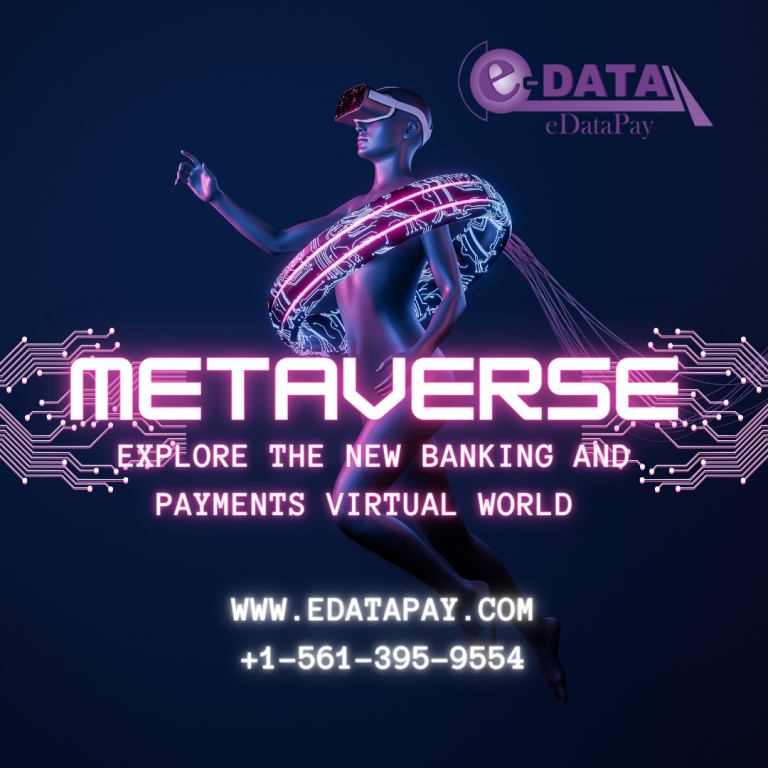Future financial institution and Metaverse
The term “Metaverse” is used to describe a virtual reality realm where people can communicate and share digital things with one another. Virtually augmented reality (VAR) and physically persistent virtual reality (PVR) have come together to produce what has been called a “virtual shared area” for users. Science fiction helped popularize the concept of the Metaverse, which is presently being developed in many forms by corporations and non-profits in the IT and entertainment industries.
Financial institutions and transaction processors would do well to keep tabs on Metaverse innovations and investigate how they may be incorporated into customer service.
As eDataPay development firm, we are continually exploring new possibilities. Especially this year, as we anticipate the possible release of AI platforms for commercial and consumer use.
A strong technology with the potential to dramatically improve the Metaverse, AI is likely to be applied in a wide variety of ways as the Metaverse develops further.
At eDataPay, we’re concerned about how this will change the course of our industry and where it’s headed next.
There are many ways in which artificial intelligence (AI) could have an outsized effect on the Metaverse and on monetary transactions:
Customization using artificial intelligence-driven customization, users of the Metaverse might have their own one-of-a-kind experiences. An example of how artificial intelligence could be put to use in the virtual world is in the form of product recommendations or user-specific avatars.
Helping users find their way about the Metaverse, as well as learning more about upcoming virtual events and assisting with financial transactions, are AI-powered virtual assistants.
Generate virtual environments and objects for usage in the Metaverse with the use of artificial intelligence (AI)-powered content creation. Using this method, it would be possible to set up new digital locations, like online shops or exhibition halls, in a short amount of time.
Interaction: AI could be utilized to generate more natural and realistic interactions with virtual things and characters. Using AI, developers may make non-player characters (NPCs) that behave and speak like actual people.
Metaverse security could be improved with the help of AI. A few potential applications include safeguarding users’ private data, detecting and preventing fraud, and keeping an eye out for suspicious behavior.
Artificial intelligence-driven analytic tools could be utilized to learn more about the Metaverse and its inhabitants. This information might be utilized to create a better Metaverse experience for users, find untapped sources of income, or even create entirely new applications for the Metaverse.
Although the long-term effects of the Metaverse on the processing and issuance of credit cards yet to be seen, it is apparent that the future of this technology may be affected by the ongoing changes in the Metaverse. Financial institutions and transaction processors would do well to monitor developments in the Metaverse and investigate how it may be used to improve customer service and the quality of products and services offered.
The development and marketing teams at eDataPay recognize that the Metaverse may have an effect on the processing and issue of credit cards. Some of the following are potential mechanisms through which this might occur:
Credit cards in virtual form: The Metaverse could serve as a launching pad for the distribution of virtual credit cards that could be used to make purchases in the virtual space. Users could use these virtual credit cards to make purchases online and have the funds automatically withdrawn to their bank account or physical credit card.
The Metaverse might potentially function as a host for VPSs, allowing virtual shops to accept credit card payments for virtual wares and services. The infrastructure for these e-commerce platforms might be provided by financial institutions and payment processors.
To store and handle virtual credit cards, digital currencies, and other types of virtual currency, the Metaverse might also serve as a platform for digital wallets. Wallets in the Metaverse may be issued and managed by financial institutions.
Banks and payment processors must also adjust to the new context and assure the safety of transactions by implementing fraud prevention methods to guard against virtual fraud, such as identity verification, transaction monitoring, and encryption.
Although its long-term effects on the financial sector remain to be seen, the Metaverse could have a significant impact in the near future. Financial institutions should keep tabs on Metaverse innovations and consider how they may be incorporated into customer care.
The exciting thing for kids and many adults who have gotten into the metaverse is that they may now have a genuine experience with banks and the financial system, beyond just the local place to use an ATM.
The term “Metaverse” is used to describe a shared digital environment in which people can communicate and collaborate using avatars. Although it is still in its infancy, the Metaverse may one day have a place in the future bank. Some possible effects on the financial sector are listed below.
The Metaverse has the potential to become a new platform for virtual banking, giving customers remote access to banking services. It is possible for banks to establish up virtual locations in the Metaverse where customers may go to do banking activities like as opening accounts, applying for loans, and so on.
The Metaverse has the potential to host digital currency, which might be utilized for in-game purchases. There is potential for financial institutions to facilitate the creation and administration of virtual currencies in the Metaverse.
Money management: The Metaverse may also serve as a novel platform for managing one’s personal finances, letting users keep tabs on their cash flow, create budgets, and otherwise manage their money in a digital setting. Banks might use the Metaverse to educate their customers and give them access to tools that would allow them to make more informed financial decisions.
The Metaverse may potentially present new opportunities for financial institutions to generate income, such as in the areas of virtual real estate and advertising.
In general, I remain committed to fostering Future Banking and the bank of the Future by supporting and collaborating with numerous SaaS firms. New and innovative goods and services, as well as more pleasant and efficient customer experiences, can result from collaborations between Fintechs and banks.
The future relationship between fintechs and banks is more likely to be one of cooperation than competition.

As the concept of the metaverse continues to evolve, there may be a number of potential needs for banks within this virtual reality space. Some possibilities include:
Virtual currency: Banks may need to develop virtual currencies or tokens that can be used within the metaverse for transactions and exchanges. These virtual currencies would need to be secure and easily exchangeable for traditional fiat currencies.
Virtual property: Banks may need to develop new ways to track, manage, and secure virtual property within the metaverse. This could include virtual real estate, virtual collectibles, and other virtual assets.
Identity verification: Banks may need to develop ways to verify the identities of users within the metaverse, in order to prevent fraud and ensure compliance with regulations.
Risk management: Banks may need to develop new risk management strategies to address the unique challenges presented by the metaverse, such as the potential for virtual theft or fraud.
Compliance: Banks may need to ensure that they are compliant with regulations in the virtual world as well as in the physical world.
Payment gateway: Banks could provide a payment gateway for transactions within the metaverse, allowing for secure and fast payments.
Virtual banking branches: Banks could open virtual branches within the metaverse, allowing customers to access banking services in a virtual environment.
Virtual financial advisors: Banks could provide virtual financial advisors to help customers navigate the unique financial opportunities and challenges presented by the metaverse.
It’s important to note that the metaverse is still a concept that’s in development and some of the needs mentioned above may change as the technology and usage of it evolves.









